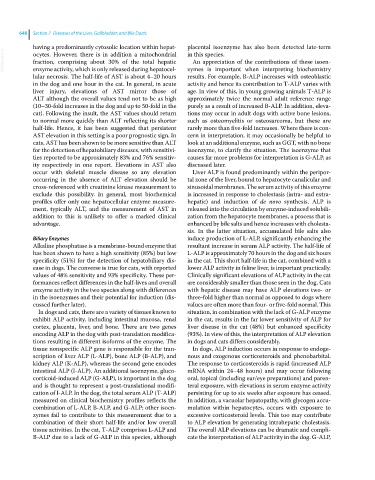Page 680 - Clinical Small Animal Internal Medicine
P. 680
648 Section 7 Diseases of the Liver, Gallbladder, and Bile Ducts
having a predominantly cytosolic location within hepat- placental isoenzyme has also been detected late‐term
VetBooks.ir ocytes. However, there is in addition a mitochondrial in this species.
An appreciation of the contributions of these isoen-
fraction, comprising about 30% of the total hepatic
enzyme activity, which is only released during hepatocel-
results. For example, B‐ALP increases with osteoblastic
lular necrosis. The half‐life of AST is about 4–20 hours zymes is important when interpreting biochemistry
in the dog and one hour in the cat. In general, in acute activity and hence its contribution to T‐ALP varies with
liver injury, elevations of AST mirror those of age. In view of this, in young growing animals T‐ALP is
ALT although the overall values tend not to be as high approximately twice the normal adult reference range
(10–30‐fold increases in the dog and up to 50‐fold in the purely as a result of increased B‐ALP. In addition, eleva-
cat). Following the insult, the AST values should return tions may occur in adult dogs with active bone lesions,
to normal more quickly than ALT reflecting its shorter such as osteomyelitis or osteosarcoma, but these are
half‐life. Hence, it has been suggested that persistent rarely more than five‐fold increases. Where there is con-
AST elevation in this setting is a poor prognostic sign. In cern in interpretation, it may occasionally be helpful to
cats, AST has been shown to be more sensitive than ALT look at an additional enzyme, such as GGT, with no bone
for the detection of hepatobiliary diseases, with sensitivi- isoenzyme, to clarify the situation. The isoenzyme that
ties reported to be approximately 83% and 76% sensitiv- causes far more problems for interpretation is G‐ALP, as
ity respectively in one report. Elevations in AST also discussed later.
occur with skeletal muscle disease so any elevation Liver ALP is found predominantly within the peripor-
occurring in the absence of ALT elevation should be tal zone of the liver, bound to hepatocyte canalicular and
cross‐referenced with creatinine kinase measurement to sinusoidal membranes. The serum activity of this enzyme
exclude this possibility. In general, most biochemical is increased in response to cholestasis (intra‐ and extra-
profiles offer only one hepatocellular enzyme measure- hepatic) and induction of de novo synthesis. ALP is
ment, typically ALT, and the measurement of AST in released into the circulation by enzyme‐induced solubili-
addition to this is unlikely to offer a marked clinical zation from the hepatocyte membranes, a process that is
advantage. enhanced by bile salts and hence increases with cholesta-
sis. In the latter situation, accumulated bile salts also
Biliary Enzymes induce production of L‐ALP, significantly enhancing the
Alkaline phosphatase is a membrane‐bound enzyme that resultant increase in serum ALP activity. The half‐life of
has been shown to have a high sensitivity (85%) but low L‐ALP is approximately 70 hours in the dog and six hours
specificity (51%) for the detection of hepatobiliary dis- in the cat. This short half‐life in the cat, combined with a
ease in dogs. The converse is true for cats, with reported lower ALP activity in feline liver, is important practically.
values of 48% sensitivity and 93% specificity. These per- Clinically significant elevations of ALP activity in the cat
formances reflect differences in the half‐lives and overall are considerably smaller than those seen in the dog. Cats
enzyme activity in the two species along with differences with hepatic disease may have ALP elevations two‐ or
in the isoenzymes and their potential for induction (dis- three‐fold higher than normal as opposed to dogs where
cussed further later). values are often more than four‐ or five‐fold normal. This
In dogs and cats, there are a variety of tissues known to situation, in combination with the lack of G‐ALP enzyme
exhibit ALP activity, including intestinal mucosa, renal in the cat, results in the far lower sensitivity of ALP for
cortex, placenta, liver, and bone. There are two genes liver disease in the cat (48%) but enhanced specificity
encoding ALP in the dog with post-translation modifica- (93%). In view of this, the interpretation of ALP elevation
tions resulting in different isoforms of the enzyme. The in dogs and cats differs considerably.
tissue nonspecific ALP gene is responsible for the tran- In dogs, ALP induction occurs in response to endoge-
scription of liver ALP (L‐ALP), bone ALP (B‐ALP), and nous and exogenous corticosteroids and phenobarbital.
kidney ALP (K‐ALP), whereas the second gene encodes The response to corticosteroids is rapid (increased ALP
intestinal ALP (I‐ALP). An additional isoenzyme, gluco- mRNA within 24–48 hours) and may occur following
corticoid‐induced ALP (G‐ALP), is important in the dog oral, topical (including ear/eye preparations) and paren-
and is thought to represent a post-translational modifi- teral exposure, with elevations in serum enzyme activity
cation of I‐ALP. In the dog, the total serum ALP (T‐ALP) persisting for up to six weeks after exposure has ceased.
measured on clinical biochemistry profiles reflects the In addition, a vacuolar hepatopathy, with glycogen accu-
combination of L‐ALP, B‐ALP, and G‐ALP; other isoen- mulation within hepatocytes, occurs with exposure to
zymes fail to contribute to this measurement due to a excessive corticosteroid levels. This too may contribute
combination of their short half‐life and/or low overall to ALP elevation by generating intrahepatic cholestasis.
tissue activities. In the cat, T‐ALP comprises L‐ALP and The overall ALP elevations can be dramatic and compli-
B‐ALP due to a lack of G‐ALP in this species, although cate the interpretation of ALP activity in the dog. G‐ALP,

